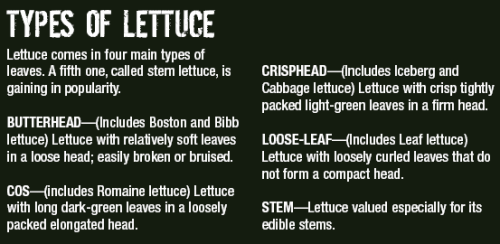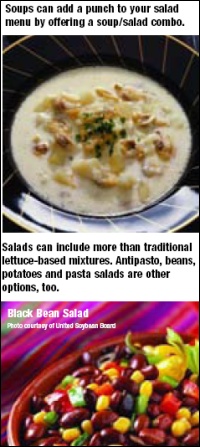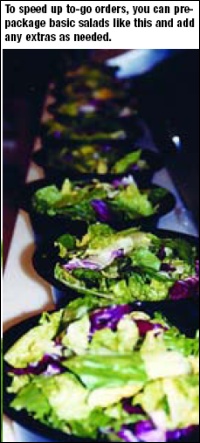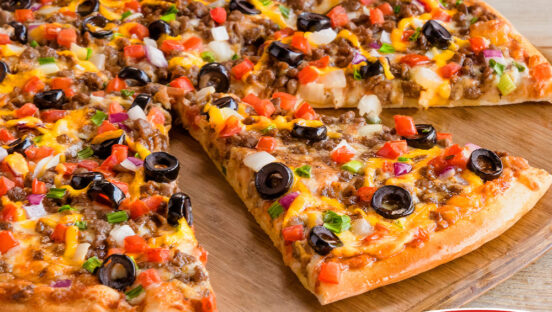We’ve discussed adding additional entrees, appetizers and desserts to a traditional pizza menu, but this is PMQ’s comprehensive report on salads. You’ll learn things to take into consideration for controlling the food cost, how to clean them and how to position them on your menu.
Salads, like appetizers and additional entrees are a great revenue booster. Salads give adults a healthy alternative to the less calorie-friendly pizza.
First things first: you have to decide what kind(s) of salad you’re going to sell. If it’s a green-based salad, the next logical step is to decide between buying the whole veggie or buying already-cut and bagged veggies (also known as “fresh cut” produce). The pros and cons for both sides are fairly obvious. You can buy head lettuce wholesale and cut it yourself for fairly cheap. Fresh-cut lettuce, while a little bit more expensive, also cuts out several other steps.
“Fresh cut lettuce is a labor saving product as well as a sanitary alternative,” Jerry Welcome, president of the International Fresh-cut Produce Association, said. “It really does minimize labor cost and heightens overall safety. Not only are you not having to wash and dry it, but you’re taking knives out of the hands of your employees, cutting back on the risk of an on-the-job injury.”
Food Cost
Figuring out food cost on salads can be a bit tricky. It’s not as cut and dry as measuring out products for pizza. For one, you have to take into account the cost of all of your ingredients. Are you using whole veggies or fresh cut produce? For fresh cut, expect to pay a bit more, but it just about evens out because you’re not having to pay for the labor it would take to slice, clean and dry the lettuce. Jerry said that the cost of fresh cut lettuce is less than it once was. “It’s so prevalent now that the cost has come down a bit,” Jerry said.
Cleaning Salads
If you buy fresh produce, you’ll need to wash it to remove any dirt or unwanted contaminants from the produce. Once your salads are clean, you then have the problem of drying your lettuce. I can almost hear the question going through your heads: “What? Dry lettuce? Whatever for??” Well, you should simply because it extends the shelf life. According to Jerry, if dried and kept in the right environment (read more about this under Buffets), your lettuce can last up to 14 days. An added bonus is that drying can enhance your salad dressing. Wet lettuce dilutes your salad dressing: rather than thick, creamy ranch dressing or zesty Italian, the dressing is diluted and can’t stick to your lettuce.
Salad Spinners
To dry salad, you can do one of several things. First, you can hand dry with a paper towel. This, however, is a very labor-intensive method, besides being impractical for drying large quantities. Another, more practical way is to invest in something called a salad spinner, which allows you to dry lettuce using centrifugal force. The lettuce is “spun” to throw the water from the leaves. If you’re not planning on producing many salads in a day, you can go with a home version, which is slightly smaller and usually hand propelled. The manual spinners range in size from one gallon to nine gallons.
Hand propelled methods include a crank spinner, pull cord spinner and pump spinner. A crank spinner is the oldest and probably cheapest method. The lid has a crank that attaches to the basket. When you turn the crank, the basket turns, throwing out water. The second method, a pull cord spinner, works like your child’s pull-string toys. When you pull the string, it spins. The third and newest version works like a top. You push the pump and it spins. When you want it to stop, you push a break button.

If you feel that you’ll be producing too much salad to use a smaller salad spinner, industrial spinners do exist, about the size of a washing machine. However, depending on the popularity of your salads, they may not be priced right to justify buying one.
Buffets
Buffets can be a demon to deal with. Like the common pizza buffet question, “should you or should you not,” you have to cross that river when it comes. Yes, buffets draw a crowd, but how do you control your food costs? Since salads are not very filling and people that order one in a pizzeria usually do so as an appetizer or side item, the food cost on a buffet probably wouldn’t skyrocket like a pizza buffet might.
Your biggest problem with a salad buffet will be preventing spoilage. Jerry said that to ensure the maximum life span (12-14 days), you need to make sure that the cold chain is never broken. The cold chain begins within a couple of hours after the product has been picked or cut. The processor/distributor refrigerates it down to between 34˚F and 38˚F. If handled correctly, the temperature of the lettuce never gets above 38˚F. Once it comes to you, whether you wash and cut it yourself or buy fresh cut, you’ll refrigerate it as well. Closed in refrigerators have no problem maintaining this temperature; however, depending on your equipment, you might have a few issues keeping the salad at the optimal temperature while on display in your dining area.
Menu Position
Salads are such a great healthy alternative to pizza that you should handle how they’re positioned on your menu carefully. You can offer it as a meal, a side item, an appetizer or any combination of the three.
Gregg Rapp, menu consultant, said that placing the salad correctly is important so as not to hurt sales of your entrees. “Most people like to see salads to the left side of the menu,” Gregg said. “Sometimes a restaurant will go in and put the appetizer section on the right side, but that’s the best spot for your entrees. Just keep it where it’s noticeable but also towards the beginning of the menu.”
You also need to think carefully about the description of the salad you include in your menu. “The more you say in the salad section, the more important it seems to the customer,” Gregg said. “So don’t just list a house salad. Tell them what’s in the salad. The more you tell about it in the description, the more value you’re giving it and the more you’ll sell.”
Even if you’re going to offer a salad as an entree, it should still be positioned on the left of the menu. If priced right, you can make more money per person on an entree salad than you will per person on a pizza (the salad will be eaten by one person, whereas the pizza is usually split between several people). An entree salad is a great way to add to your takeout business and profit to an individual order.
 |
  |
Soup Up Your Salad
Make your normal, everyday salad great just by adding in some “extras.” Look into things like lettuce mixes and adding chicken or ham cubes. Lettuce mixes give customers a little bit of and adding meat ups the stomach-filling quality of the salad as well as allowing you to up the price on the item.
Other things that are fairly easy to add, and add up, are bacon and cheese for extra flavor and chowmein and sunflower seeds for a little extra crunch. Chopped, boiled eggs and shredded carrots, while not hard to do are that little extra effort on your part that customers love.
Salad Dressing and Tomatoes
Owner’s need to remember additional costs that go with salads, namely dressings. There are a wide variety of kinds and brands of dressings, each with a loyal following. You’re going to want a few different dressings for your customers’ choice. The most common are ranch, Thousand Island, blue cheese, honey mustard and Italian dressings. But take it one step further. Rather than just offering a straight version, personalize it for your store and add some spices or other flavors so that customers can only get your dressing at your restaurant.
If you offer to deliver your salads or offer them “to-go,” you also have to look into prepackaging salad dressings. You can personally fill a container with dressing or take a look at bought prepackaged salad dressing. You wouldn’t want to just put a blob of salad dressing because it shortens the shelf life of your salad. The easiest way to do this is to buy the salad dressing already in individualized packets. McDonalds does this with Newman’s Own dressing for their salads. It can just sit in the same container as the salad without doing any harm to the overall quality. You can also use small sauce cups with lids to package your bulk dressings.
There are a few other things to keep in mind. One is the addition of tomatoes. Should you decide to offer pre-prepared salads instead of a buffet, Jerry recommends not putting cut tomatoes on the salad. “Tomatoes have a different life span than lettuce,” Jerry said. “If there’s the possibility of them being on the salad longer than two hours, I wouldn’t put them on.” One thing that you can do is to use cherry tomatoes instead of regular slice tomatoes.
As you can see, there are quite a few choices to consider. Take your time and do your homework: ask your local distributor what problems you’d have to overcome on that side and do some research on what types would work best for you.













